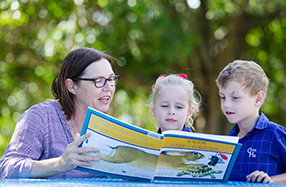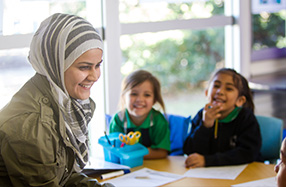Working together to maximise student learning
The department's Parent and community engagement framework helps students, schools, parents and the community to work together to maximise student learning and wellbeing. Research shows parent and community engagement that is effectively focused on student learning can deliver powerful outcomes (OECD, 2011).
Why is parent and community engagement important?
Research shows that the most successful schools engage students, parents, carers and the community as partners in supporting student learning and wellbeing. Many schools have already developed strategies to engage with parents and community. The overwhelming evidence that parent engagement has a positive effect on student achievement has led to all state schools and their communities being encouraged to strengthen their engagement—with and between students, teachers, parents and carers, support staff, community, industry and business groups.
This framework outlines 5 key elements of parent and community engagement to make a positive difference in our students' education.
Key elements of the framework
Communication

Effective communication between schools, parents, students and the community forms the foundation for developing and maintaining partnerships. To have a significant impact on student outcomes, communication needs to be focused on student learning and wellbeing. It must also be a genuine exchange of information and ideas between the student, the school, the home and the community.
Schools have a responsibility to help parents understand the 'language of learning' including the terms used by teachers in the classroom with students to communicate learning goals and expectations. This will assist parents to discuss learning with their child at home and to effectively communicate with teachers using a common language.
Points to consider
- Is student progress communicated to parents in a positive and meaningful way? How? Are parents advised of student's strengths as well as areas for improvement?
- Is it clear what teachers and parents need to discuss? How is this communicated?
- Is the school using language that is clear and accessible to parents and students and helpful for exploring learning development, challenges and success?
- How can school leaders work with parents and the community to establish a shared set of expectations about schooling?
- What practices support communication between the school and parents' individual circumstances including working parents, rural and remote parents and parents with a disability?
- What practices support communication between the school and parents from diverse backgrounds, including Aboriginal and Torres Strait Islander parents, and parents who have English as an Additional Language or Dialect?
- Do all parents feel comfortable communicating with school staff? Do parents know the school's preferred communication channels? Is the school flexible with these arrangements? Does the school know parents' preferred modes of communication?
- Is genuine communication occurring between the school and Aboriginal and Torres Strait Islander parents, families and community Elders?
- How does the school communicate with industry and business partners?
Access a copy of the
communication element of the Parent and Community Engagement Framework.
Partnerships with parents

Quality partnerships require a reciprocal commitment from staff and parents to work together to improve student learning and wellbeing.
Learning is not limited to the classroom. The beliefs, expectations and experience of parents are powerful determinants in students' achievement. Effective partnerships can help to raise parents' awareness of their ability to improve their children's learning and wellbeing. Understanding the school, home and community contribution to student learning helps cultivate a holistic learning environment.
While involving parents in school activities (e.g. volunteering, fund raising, attending school events) is important, it is engagement through learning partnerships which has been shown to have much greater impact on student outcomes (Harris, Andrew-Power, & Goodall, 2009, pp. 12–13).
Points to consider
- How do school personnel build a whole-school commitment to engaging with parents?
- How can schools support parents to be positively engaged with their child's learning, at home and at school?
- How does the school ensure that it is inclusive of all parents in the school including parents with different cultural and educational backgrounds, working arrangements, and communication requirements?
- How can teachers and parents work together to help children learn?
- How does the school find out what would help parents?
- How do teachers seek to understand and learn about students, including their home situation and culture?
- How can parents better support teachers?
Access a copy of the
partnerships with parents element of the Parent and Community Engagement Framework.

Schools do not exist in isolation – they are often the central hub of their community. Schools should leverage their position in the community to work together with other community members, for the benefit of all.
Effective collaboration provides opportunities for schools to develop a better understanding of their broader community and to build strong relationships within their local context.
Community members and organisations offer unique knowledge, expertise and perspectives that schools can use to enhance student wellbeing and make learning more authentic and connected.
Community approaches to learning improvement make it possible for schools to form strategic partnerships with families and community organisations. This type of collaboration can help address issues external to the school and better support students' learning and wellbeing and their ability to come to school ready and able to learn.
Points to consider
- What are the key characteristics and strengths of the community (for example, demography, diversity, geographic location, local industries)?
- What can the community do to support the school in areas such as drug education, antibullying, civic responsibility and the development of social skills?
- What does the community, including local employers, expect from the school? How can they help students?
- How do community members/organisations show their commitment to working with the school? What is the purpose of the engagement?
- Has a genuine collaborative relationship been established between the school and Aboriginal and Torres Strait Islander communities and individuals?
- How can the school leverage community, industry and business knowledge and skills?
- Are there opportunities to develop relationships with the community that could deliver more innovative models of education and training?
- How does the school create clarity around roles and responsibilities in the relationships it forms with community organisations and groups?
Access a copy of the
community collaboration element of the Parent and Community Engagement Framework.
Decision-making

Parent and community involvement in school decision-making encourages greater ownership and ensures local needs are reflected. Decisions about student needs should include effective consultation and collaboration with stakeholders and open and transparent communication at all stages of the process.
To support informed decision-making, parents and community members need to understand the purpose, aims and background to the issue, as well as the findings of any relevant evidence-based research.
Reciprocal trust and ownership of decisions assists successful implementation.
Points to consider
- To what extent are goals, progress and achievements systematically and regularly monitored and refined if required?
- Is consultation and collaboration encouraging, open and honest?
- Does the school offer training and support to build parent leadership capacity, empowering parents to participate effectively in consultation?
- Does the school collaborate with the community by consulting on formal/informal decision-making, reviews and new school policies (for example, assessment, reporting and curriculum changes)? How?
- Has the school considered how it will include local Aboriginal and Torres Strait Islander parents, Elders and community groups in decision-making processes?
- Are parents and community partners consulted as part of decision-making on issues in which they have particular expertise?
Access a copy of the
decision-making element of the Parent and Community Engagement Framework.
School culture

Respectful relationships between the school, students, parents and the school community need to be actively cultivated and valued.
Nurturing a culture that respects and values difference amongst the whole school community is vital in supporting the inclusive engagement of all families.
Parent and community participation in student learning and the school community should be acknowledged and recognised. This involvement sends a clear signal to students about the value of education.
Points to consider
- How is the school welcoming and supportive of all children and parents?
- What opportunities are given for parents and community members to participate in school activities?
- How does the school support and maintain mutually respectful relationships across its community?
- How does the school appreciate and value students' varying cultural backgrounds?
- How does the principal and senior management team build the cultural competence of school staff?
- How can volunteers contribute to teaching, learning and wellbeing?
- How does the school community recognise and support volunteers?
- Are parents notified about major events well in advance so they can plan ahead? How?
- Does the school celebrate significant cultural days and events reflective of the broader Queensland community (for example, NAIDOC)?
Access a copy of the
school culture element of the Parent and Community Engagement Framework.